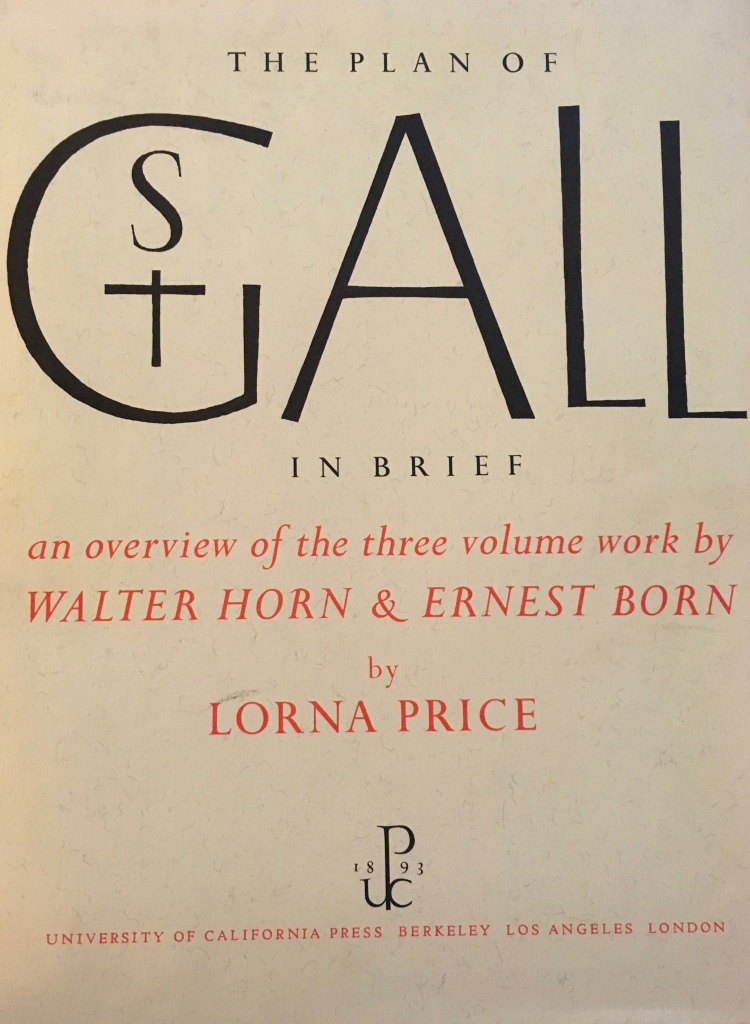The art of the monastic tradition at Reichenau reached one of its pinnacles with the development of a great architectural plan for a newly developed abbey at St. Gallen. Monks on the island created this medieval gem, and it exists today as one of the treasures of the Stiftsbibliotek at St. Gallen.
The stitched-together vellum manuscript of the plan was used on the reverse side for an unrelated text. You can see some of it on the lower left of the above image, and you can also see some of the text showing through on the bottom fourth of the manuscript. (Never wasting a precious treated animal hide vellum led to the creation of palimpsests in which the earlier text was scraped away and then replaced by new writing. New scanning technology sometimes allows scholars to read the earlier text of the palimpsest. And occasionally this yields an earlier version of an extant text or even one we thought was lost.)
A really gorgeous set of volumes was produced by the University of California Press in the 1980s called The Plan of St. Gall, and I found a used copy on Amazon of its smaller offspring volume, The Plan of St. Gall in Brief, which is a large-format book with amazing illustrations and stellar typography and an overview of the architectural history of the multi-volume set. The architects Horn and Born took the original vellum and redrew portions of it to allow us to see what the intended sections of the monastery design entailed.
The book shows different schematics for the ways parts of the abbey design were intended for use, a really superb map of the journeys of Irish monasticism (starting with the desert fathers and mothers and extending through Columba and Columbanus), and also photos of the 3-D wooden model the two architects created (which is now in the lower level of the Library in St. Gallen).

It becomes clear that monasteries were not only housing for a group of men at prayer…they were hospitals, community centers, agricultural and craft centers, breweries, hotels, pharmacies, libraries, publishing houses, churches, and places of scholarship and learning. And they sometimes, like St. Gallen, they became seats of government as well. (In fact some cantonal offices are housed today in the old abbey buildings.)
One of my favorite bits of the plan shows the area that is reserved for housing people like me: “Pilgrims and Paupers” (domus peregrinorum et pauperum). I’m grateful to fall into the “pilgrim” category! ; ) You can also see a camera (room for servants) and a storage cellar in the upper part of the drawing and in the lower is a very functional kitchen design with an oven (fornax) on the right and a brewery on the left.

I am certain that Columbanus had now idea how his monastery would grow. And it was not just in St. Gallen. As I will show in a later blog post, the monasteries he founded became the backbone of continental monasticism in northern Italy and north of the Alps.
One of the questions I posed for myself as I started the pilgrimage was to try and learn more about what gave the monasteries such staying power. To have been founded around 600 and to endure until the time of the French Revolution or the Napoleonic Wars is no small feat. I surmise that part of the reason is that they were not unidimensional institutions that existed only as a place of prayer (which was, of course, their primary function). I remember being on Skellig Michael off the southwest coast of Ireland and learning that part of the monks’ function there – at the edge of the known world – was to effectively create a “force field” of prayer to protect “the world” from the unknown forces of evil in lands unknown beyond the Atlantic. (And this was even before Donald Trump…Maybe we need some monastic “spiritual repellant” again!)
When I think of the ways our church building in Fort Collins is used, it is a far smaller but still essential part of our physical plant. Yes, the primary mission of our church is “to worship God” but it also includes helping to “make God’s realm visible in the lives of people,” and that may take the form of using our space to interview clients for the Homelessness Prevention Initiative or to provide a home for Prairie Mountain Zendo or for Alcoholics Anonymous or for the Interfaith Hospitality Network or any of the many community groups that call our building home. It gives us staying power and helps us to reach our stated mission.

The monasteries also became part of wider networks: the Catholic Church, the paruchia or family of monastic houses in the Irish tradition, and eventually part of later monastic traditions (some Benedictine, Franciscan, Cistercian, Augustinian, etc.). That reliance on broader networks of support and accountability is something we independent-minded Americans sometimes neglect, thinking that we can go it alone. Sometimes in my tradition (rooted in Congregationalism) we think that the only “real” church is the local congregation, and while that works in the short term, when bad things happen (e.g., a fire, clergy misconduct, congregational misconduct, search and call) it is essential to have a wider church to draw upon. We’ve adjusted our way of thinking and also our ecclesiology (theology of what the church is and ought to be) and we will continue to do so.
Leaving the area of monasteries around the Bodensee, the next stop is to Columbanus’s first monasteries at Annegray and Luxeuil in the Vosges region of France. Stay tuned!